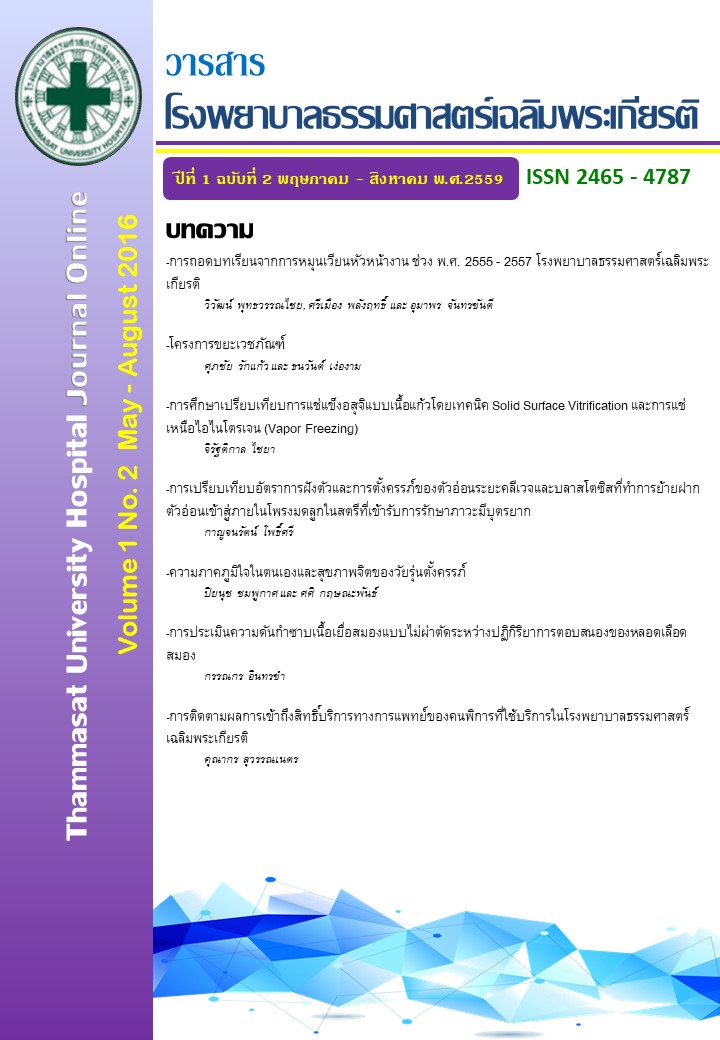การเปรียบเทียบอัตราการฝังตัวและการตั้งครรภ์ของตัวอ่อนระยะคลีเวจและ บลาสโตซิสที่ทำการย้ายฝากตัวอ่อนเข้าสู่ภายในโพรงมดลูกในสตรีที่เข้ารับการรักษาภาวะมีบุตรยาก
คำสำคัญ:
ตัวอ่อนระยะคลีเวจ, ตัวอ่อนระยะบลาสโตซิส, อัตราการฝังตัว, อัตราการตั้งครรภ์บทคัดย่อ
การศึกษานี้มีวัตถุประสงค์เพื่อเปรียบเทียบอัตราการฝังตัวและการตั้งครรภ์ของตัวอ่อนระยะคลีเวจ (cleavage) และบลาสโตซิส (blastocyst ) ที่ทำการย้ายฝากเข้าสู่ภายในโพรงมดลูกในสตรีที่เข้ารับการรักษาภาวะมีบุตรยาก
การศึกษาครั้งนี้เป็นการศึกษาข้อมูลย้อนหลัง (retrospective study) โดยตรวจสอบอัตราการฝังตัวและการตั้งครรภ์ในกลุ่มสตรีที่เข้ารับการรักษาภาวะมีบุตรยากโดยการย้ายตัวอ่อนรอบสด (fresh embryo transfer: fresh-ET) และรอบการย้ายฝากตัวอ่อนผ่านการแช่แข็งมาแล้ว (frozen embryo thansfer: FET) ในสตรีที่อายุน้อยกว่า 35 ปี และอายุมากกว่าหรือเท่ากับ 35 ปีขึ้นไป และการศึกษานี้เป็นการศึกษาข้อมูลย้อนหลังระหว่างวันที่ 1 เดือนมกราคม 2553 – วันที่ 31 เดือนธันวาคม 2557
ผลการศึกษาไม่พบความแตกต่างอย่างมีนัยสำคัญทางสถิติของอัตราการฝังตัว (implantation rate) และการตั้งครรภ์ (pregnancy rate) ในสตรีที่ทำการย้ายด้วยตัวอ่อนระยะ cleavage และ blastocyst ในการย้ายฝากตัวอ่อนรอบ fresh ET ทั้งในสตรีที่อายุน้อยกว่า 35 ปี และกลุ่มสตรีที่อายุมากกว่าหรือเท่ากับ 35 ปี ส่วนการย้ายฝากตัวอ่อนในรอบ FET พบว่าอัตราการฝังตัวในการย้ายฝากตัวอ่อนระยะ blastocyst สูงขึ้นอย่างมีนัยสำคัญทางสถิติทั้งในกลุ่มสตรีที่อายุน้อยกว่า 35 ปี (odd ratio = 2.260; p-value = 0.023) กับการย้ายฝากตัวอ่อนระยะ cleavage แต่อัตราการตั้งครรภ์ไม่มีความแตกต่างกันเมื่อทำการย้ายฝากตัวอ่อนทั้ง 2 ระยะ ในกลุ่มสตรีที่อายุมากกว่าหรือเท่ากับ 35 ปี (odd ratio = 1.943; p-value = 0.011) เมื่อเปรียบเทียบ การศึกษานี้พบว่าการย้ายตัวอ่อนในรอบ FET ด้วยตัวอ่อนระยะ blastocyst มีค่า implantation rate สูงกว่าการย้ายตัวอ่อนระยะ cleavage อย่างมีนัยสำคัญทั้งในกลุ่มสตรีอายุน้อยกว่า 35 ปี และอายุมากกว่าหรือเท่ากับ 35 ปี ส่วนการย้ายตัวอ่อนระยะ cleavage และ blastocyst ในรอบ fresh ET ในกลุ่มสตรีที่อายุน้อยกว่า 35 ปีและกลุ่มสตรีที่อายุมากกว่าหรือเท่ากับ 35 ปี พบว่า implantation และ pregnancy rate ไม่แตกต่างกัน จากการศึกษานี้สรุปได้ว่าควรทำการรักษาภาวะมีบุตรยากโดยการย้ายฝากตัวอ่อนระยะ blastocyst ในสตรีทุกช่วงอายุในรอบ FET ซึ่งช่วยเพิ่มให้อัตราของผลสำเร็จสูงขึ้น
References
จรรยา ภัทรอาชาชัย. (2551). ชีวสถิติสำหรับงานวิจัยทางการแพทย์. ปทุมธานี: มหาวิทยาลัยธรรมศาสตร์.
Angell, R. R. (1994). Aneuploidy in older women. Higher rates of aneuploidy in oocytes from older women. Hum Reprod, 9(7), 1199-1200.
Barrenetxea, G., Lopez de Larruzea, A., Ganzabal, T., Jimenez, R., Carbonero, K., &Mandiola, M. (2005). Blastocyst culture after repeated failure of cleavage-stage embryo transfers: a comparison of day 5 and day 6 transfers. FertilSteril, 83(1), 49-53. doi:10.1016/j.fertnstert.2004.06.049
Beesley, R., Robinson, R., Propst, A., Arthur, N., & Retzloff, M. (2009). Impact of day 3 or day 5 embryo transfer on pregnancy rates and multiple gestations. Fertil Steril, 91(5), 1717-1720. doi:10.1016/j.fertnstert.2008.02.003
Cummins, J. M., Breen, T. M., Harrison, K. L., Shaw, J. M., Wilson, L. M., & Hennessey, J. F. (1986). A formula for scoring human embryo growth rates in in vitro fertilization: its value in predicting pregnancy and in comparison with visual estimates of embryo quality. J In Vitro Fert Embryo Transf, 3(5), 284-295.
Eichenlaub-Ritter, U., Vogt, E., Yin, H., &Gosden, R. (2004).Spindles, mitochondria and redox potential in ageing oocytes.Reprod Biomed Online, 8(1), 45-58.
Elder, K., & Dale, B. (2000). In vitro fertilization. 2nded. Cambridge: Cambridge University Press, 167-80.
Gardner, D.K., & Schoolcraft, W.D. (1999).In vitro culture of human blastocyst. In: Jansen, R., Mortimer, D. editor. Towards reproductive certainly: fertility and genetics beyond 1999. New York: Parthenon Publish Group, 378-88.
Hill, G. A., Freeman, M., Bastias, M. C., Rogers, B. J., Herbert, C. M., 3rd, Osteen, K. G., & Wentz, A. C. (1989). The influence of oocyte maturity and embryo quality on pregnancy rate in a program for in vitro fertilization-embryo transfer.FertilSteril, 52(5), 801-806.
Kang, S. M., Lee, S. W., Jeong, H. J., Yoon, S. H., Lim, J. H., & Lee, S. G. (2011). Comparison of elective single cleavage-embryo transfer to elective single blastocyst-embryo transfer in human IVF-ET.ClinExpReprod Med, 38(1), 53-60. doi:10.5653/cerm.2011.38.1.53
Karaki, R. Z., Samarraie, S. S., Younis, N. A., Lahloub, T. M., & Ibrahim, M. H. (2002). Blastocyst culture and transfer: a step toward improved in vitro fertilization outcome. FertilSteril, 77(1), 114-118.
Leeton, J. (1992). Patient selection for assisted reproduction. Baillieres Clin Obstet Gynaecol, 6(2), 217-227.
Milki, A. A., Hinckley, M. D., Fisch, J. D., Dasig, D., & Behr, B. (2000).Comparison of blastocyst transfer with day 3 embryo transfer in similar patient populations.FertilSteril, 73(1), 126-129.
Navot, D., Bergh, P. A., Williams, M. A., Garrisi, G. J., Guzman, I., Sandler, B., & Grunfeld, L. (1991).Poor oocyte quality rather than implantation failure as a cause of age-related decline in female fertility. Lancet, 337(8754), 1375-1377.
Pantos, K., Makrakis, E., Stavrou, D., Karantzis, P., Vaxevanoglou, T., &Tzigounis, V. (2004). Comparison of embryo transfer on day 2, day 3, and day 6: a prospective randomized study. FertilSteril, 81(2), 454-455. doi:10.1016/j.fertnstert.2003.07.016
Reh, A., Fino, E., Krey, L., Berkeley, A., Noyes, N., &Grifo, J. (2010).Optimizing embryo selection with day 5 transfer.FertilSteril, 93(2), 609-615. doi:10.1016/j.fertnstert.2009.02.070
Schoolcraft, W. B., & Gardner, D. K. (2000). Blastocyst culture and transfer increases the efficiency of oocyte donation. FertilSteril, 74(3), 482-486.
Wei, Y. H., Ma, Y. S., Lee, H. C., Lee, C. F., & Lu, C. Y. (2001). Mitochondrial theory of aging matures--roles of mtDNA mutation and oxidative stress in human aging. Zhonghua Yi XueZaZhi (Taipei), 64(5), 259-270.
Zech, N. H., Lejeune, B., Puissant, F., Vanderzwalmen, S., Zech, H., &Vanderzwalmen, P. (2007). Prospective evaluation of the optimal time for selecting a single embryo for transfer: day 3 versus day 5. FertilSteril, 88(1), 244-246. doi:10.1016/j.fertnstert.2006.11.070


